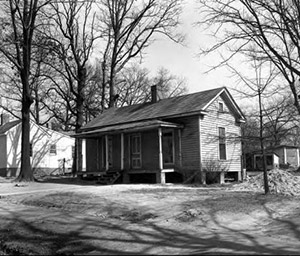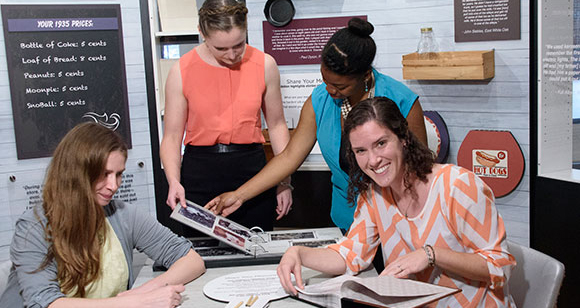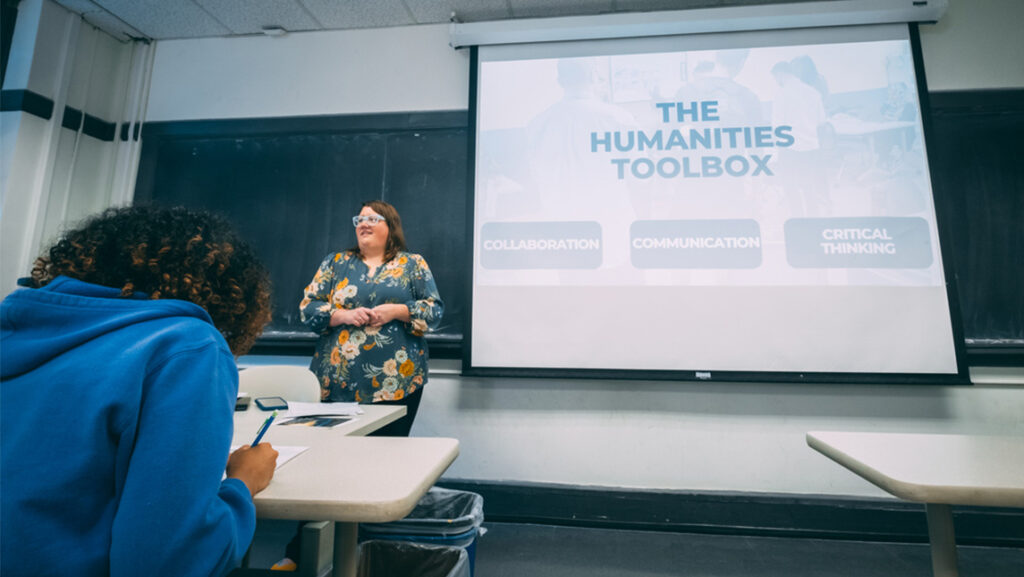Repost from UNCG Now
Long before Greensboro was known for ACC basketball, BBQ and the arts, the small southern town was synonymous with two words: blue jeans.
The arrival of textile manufacturing company Cone Mills Inc. and its four factories around the turn of the 20th century quickly transformed Greensboro into a global hub for denim and flannel.
Now, more than a century later, students in UNCG’s graduate museum studies program have unveiled what life was like for the individuals – known as mill villagers – who built “King Denim” from the ground up.
Last month, UNCG Director of Public History Dr. Benjamin Filene and his graduate students opened their exhibition “The Fabric of Memory: The Cone Mill Villages of Greensboro” at Revolution Mill, a 45-acre historic textile campus just north of downtown Greensboro.
![From left to right: UNCG graduate students Libby Clark, Amanda Holland, Candace Cook, Jason Baum, Courtney Little, Crystal Kulhanek, Katie DeMar-Aldrich, Jessica Bierman and Kimber Heinz and UNCG Director of Public History Dr. Benjamin Filene. [Photography by Martin W. Kane]](https://research.uncg.edu/wp-content/uploads/2017/04/millvillagers-29998-E.jpg)
According to Filene, Greensboro’s mill villagers have “a complicated history” due to their complex relationship with factory owners. While he notes that these communities often served as a way for companies to control their workers, many former mill villagers feel grateful for the jobs and opportunities they had.
“Former mill villagers remember their childhoods with fondness, but there’s also a recognition that they wouldn’t want to go back to that life today,” Filene said. “As a community, they feel very passionate about their history and they want their viewpoints recognized.”
The exhibit is the result of nearly 50 oral interviews recorded by the nine students and two previous cohorts that worked under Filene. From project management to development of the exhibit experience, students were deeply involved in the entire process. UNCG students worked with Raleigh-based Design Dimension on the exhibit design.

“I think this experience really helped confirm why I wanted to break into this field in the first place,” said Libby Clark, who graduated on May 6. “It is really powerful to listen to others’ experiences and have them trust you with their stories and memories.”
“We’ve received a lot of positive feedback from former villagers,” said Katie DeMar-Aldrich, who also graduated this May. “I think a lot of them are proud to share their personal histories with their children and grandchildren.”
Like other communities during this time period, mill villagers experienced the barriers of segregation. A large focus of the exhibit is East White Oak, a village that housed only African Americans.
“The students spent a lot of time on East White Oak to make sure its voices were not silenced,” Filene said. “We felt a responsibility to do justice to their perspectives and their lives.”
Filene and his students hope that through the exhibit, Greensboro residents will have a richer understanding of the city’s history.
“I think exhibits like this can deepen your sense of place,” Filene said. “It’s important to understand the people that made their lives here before we did.”
The exhibit is located at 1250 Revolution Mill Drive and is open from 9 a.m. to 5 p.m., Monday through Friday.
By Alyssa Bedrosian
Repost from UNCG Now
To learn more, also check out “The Birth of King Denim” on WUNC’s “The State of Things.” Host Frank Stasio talks about the exhibit with Dr. Filene, recent grad Crystal Kulhanek, and former mill villager Judith Sams.



